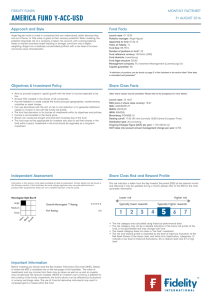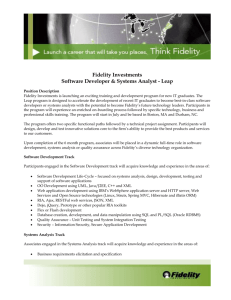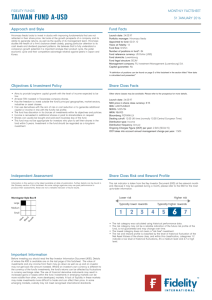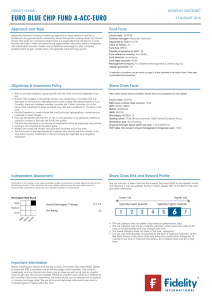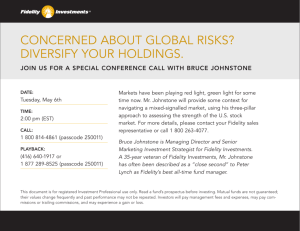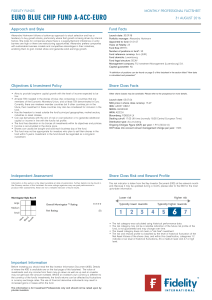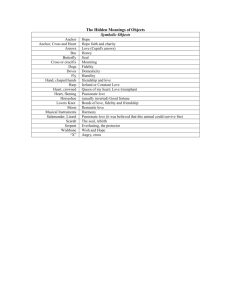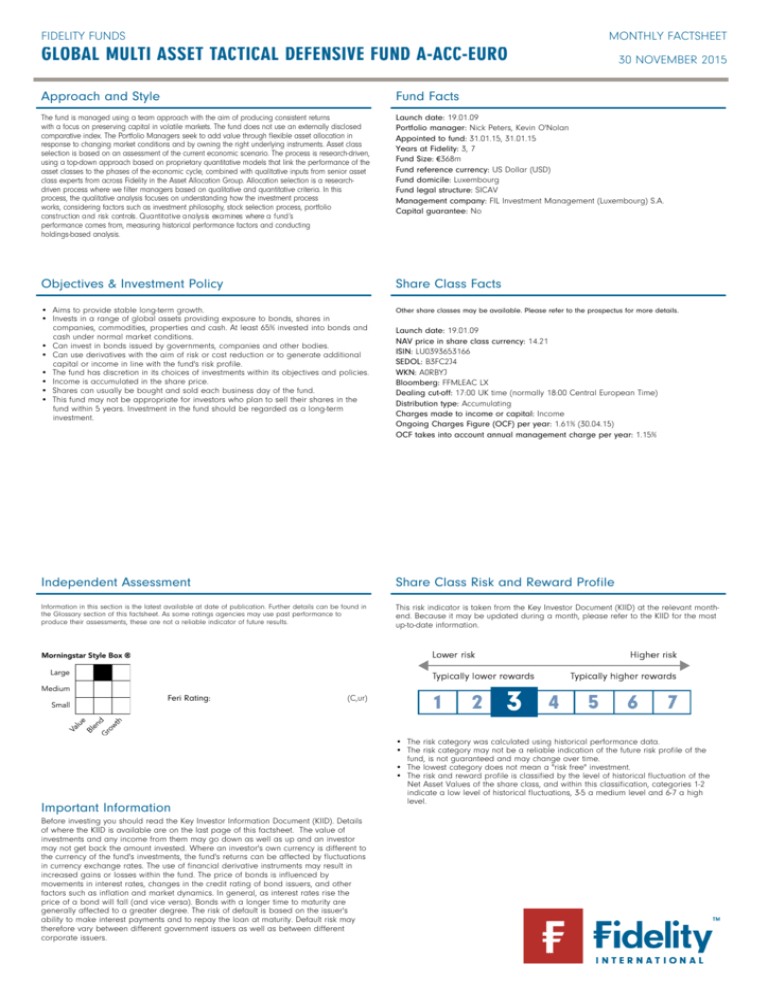
ret.en.xx.20151130.LU0393653166.pdf
FIDELITY FUNDS
GLOBAL MULTI ASSET TACTICAL DEFENSIVE FUND A-ACC-EURO
MONTHLY FACTSHEET
30 NOVEMBER 2015
Approach and Style
Fund Facts
The fund is managed using a team approach with the aim of producing consistent returns
with a focus on preserving capital in volatile markets. The fund does not use an externally disclosed
comparative index. The Portfolio Managers seek to add value through flexible asset allocation in
response to changing market conditions and by owning the right underlying instruments. Asset class
selection is based on an assessment of the current economic scenario. The process is research-driven,
using a top-down approach based on proprietary quantitative models that link the performance of the
asset classes to the phases of the economic cycle, combined with qualitative inputs from senior asset
class experts from across Fidelity in the Asset Allocation Group. Allocation selection is a researchdriven process where we filter managers based on qualitative and quantitative criteria. In this
process, the qualitative analysis focuses on understanding how the investment process
works, considering factors such as investment philosophy, stock selection process, portfolio
construction and risk controls. Quantitative analysis examines where a fund’s
performance comes from, measuring historical performance factors and conducting
holdings-based analysis.
Launch date: 19.01.09
Portfolio manager: Nick Peters, Kevin O'Nolan
Appointed to fund: 31.01.15, 31.01.15
Years at Fidelity: 3, 7
Fund Size: €368m
Fund reference currency: US Dollar (USD)
Fund domicile: Luxembourg
Fund legal structure: SICAV
Management company: FIL Investment Management (Luxembourg) S.A.
Capital guarantee: No
Objectives & Investment Policy
Share Class Facts
• Aims to provide stable long-term growth.
• Invests in a range of global assets providing exposure to bonds, shares in
companies, commodities, properties and cash. At least 65% invested into bonds and
cash under normal market conditions.
• Can invest in bonds issued by governments, companies and other bodies.
• Can use derivatives with the aim of risk or cost reduction or to generate additional
capital or income in line with the fund's risk profile.
• The fund has discretion in its choices of investments within its objectives and policies.
• Income is accumulated in the share price.
• Shares can usually be bought and sold each business day of the fund.
• This fund may not be appropriate for investors who plan to sell their shares in the
fund within 5 years. Investment in the fund should be regarded as a long-term
investment.
Other share classes may be available. Please refer to the prospectus for more details.
Independent Assessment
Share Class Risk and Reward Profile
Information in this section is the latest available at date of publication. Further details can be found in
the Glossary section of this factsheet. As some ratings agencies may use past performance to
produce their assessments, these are not a reliable indicator of future results.
This risk indicator is taken from the Key Investor Document (KIID) at the relevant monthend. Because it may be updated during a month, please refer to the KIID for the most
up-to-date information.
Feri Rating:
Launch date: 19.01.09
NAV price in share class currency: 14.21
ISIN: LU0393653166
SEDOL: B3FC2J4
WKN: A0RBYJ
Bloomberg: FFMLEAC LX
Dealing cut-off: 17:00 UK time (normally 18:00 Central European Time)
Distribution type: Accumulating
Charges made to income or capital: Income
Ongoing Charges Figure (OCF) per year: 1.61% (30.04.15)
OCF takes into account annual management charge per year: 1.15%
(C,ur)
Important Information
Before investing you should read the Key Investor Information Document (KIID). Details
of where the KIID is available are on the last page of this factsheet. The value of
investments and any income from them may go down as well as up and an investor
may not get back the amount invested. Where an investor's own currency is different to
the currency of the fund's investments, the fund's returns can be affected by fluctuations
in currency exchange rates. The use of financial derivative instruments may result in
increased gains or losses within the fund. The price of bonds is influenced by
movements in interest rates, changes in the credit rating of bond issuers, and other
factors such as inflation and market dynamics. In general, as interest rates rise the
price of a bond will fall (and vice versa). Bonds with a longer time to maturity are
generally affected to a greater degree. The risk of default is based on the issuer's
ability to make interest payments and to repay the loan at maturity. Default risk may
therefore vary between different government issuers as well as between different
corporate issuers.
• The risk category was calculated using historical performance data.
• The risk category may not be a reliable indication of the future risk profile of the
fund, is not guaranteed and may change over time.
• The lowest category does not mean a "risk free" investment.
• The risk and reward profile is classified by the level of historical fluctuation of the
Net Asset Values of the share class, and within this classification, categories 1-2
indicate a low level of historical fluctuations, 3-5 a medium level and 6-7 a high
level.
ret.en.xx.20151130.LU0393653166.pdf
FIDELITY FUNDS
MONTHLY FACTSHEET
GLOBAL MULTI ASSET TACTICAL DEFENSIVE FUND A-ACC-EURO
30 NOVEMBER 2015
These figures relate to the fund’s past performance, which is not a reliable indicator of future results. The value of investments and any income from them may go down as well as
up and an investor may not get back the amount invested.
Cumulative performance in EUR (rebased to 100)
Performance for 12 month periods in EUR (%)
Fund
Fund
Performance is shown for the last five years (or since launch for funds launched within that period).
Performance for calendar years in EUR (%)
Volatility & Risk (3 years)
Annualised Volatility: fund (%)
4.70
Sharpe Ratio: fund
1.41
Definitions of these terms can be found in the Glossary section of this factsheet.
Fund
Performance to 30.11.15 in EUR (%)
Since
19.01.09*
1m
3m
YTD
1yr
3yr
5yr
Fund cumulative growth
3.6
5.5
5.8
6.8
21.6
25.2
42.1
Fund annualised growth
-
-
-
6.8
6.7
4.6
5.3
Ranking within Peer Group Universe
-
-
-
-
-
-
Total number of funds
-
-
-
-
-
-
Quartile ranking**
-
-
-
-
-
-
Source of fund performance and volatility and risk measures is Fidelity. Performance is excluding initial charge.
Basis: nav-nav with gross income reinvested, in EUR, net of fees.
Market indices are sourced from RIMES and other data is sourced from third-party providers such as Morningstar.
*Performance commencement date.
**Quartile rank refers to performance over time rated on a scale of 1-4. A ranking of 1 indicates that the item being ranked is in the top 25% of the sample and so on.
Rankings are based on a share class that is included in the Peer Group Universe, and may not be the share class of this factsheet over the entire period.
2
ret.en.xx.20151130.LU0393653166.pdf
FIDELITY FUNDS
MONTHLY FACTSHEET
GLOBAL MULTI ASSET TACTICAL DEFENSIVE FUND A-ACC-EURO
30 NOVEMBER 2015
Introduction
This factsheet contains information about the composition of the fund at a particular point in time. It aims to help you understand how the fund manager is
positioned to achieve the fund’s objectives.
The asset class breakdown displays the totals for investments (which could include derivatives) in each category. Where derivatives are held, their
contribution to the total is included on an exposure basis – ie an amount equivalent to the value that would have been invested in a fund to produce an
equivalent holding. Where derivatives are used they may cause fund totals to exceed 100% (although very minor differences could be attributable to
rounding).
The Top Allocations table provides the next level of detail, showing the manager’s choice of investment disciplines, funds or other holdings across the sub
asset classes. It includes cash held as a strategic investment. Investment disciplines includes the use of “pools”. For internal management purposes, Fidelity
forms “pools” to co-manage assets from different funds. (These pools are not directly available to customers and do not constitute separate entities.)
Breakdown by Asset Class (% TNA)
Total Return Strategies
Bonds
Equities
Cash and Other Strategies
Commodities
Property
Uninvested Cash & Other
Breakdown within Asset Class (% TNA)
45.1
24.9
14.3
11.3
3.2
2.0
0.0
Asset Class
Total Return Strategies
Sub-Asset Class
Relative Value
Opportunistic Trades
Alternatives
Bonds
Global Fixed Income
Equities
North America Equity
Global Equity
Pan Europe
Emerging Market Equity
Japan Equity
Pacific ex Japan Equity
Cash and Other Strategies
Cash and Other Assets
Commodities
Commodities
Top Allocations (% TNA)
Property
Property
Allocation
Sub-Asset Class
Fidelity Funds - Solutions Relative Value Pool Relative Value
Uninvested Cash & Other
Total
% TNA
24.0
Fidelity Funds - US Dollar Cash
Cash and Other Assets
11.3
Fidelity Funds - Solutions Opportunistic Pool
Opportunistic Trades
10.9
Fidelity Funds - Solutions Alternative Pool
Alternatives
10.2
FF Euro Bond
Global Fixed Income
7.8
Fidelity Funds - US Dollar Bond
Global Fixed Income
5.2
FF Euro Short Term Bond
Global Fixed Income
5.1
Fidelity Funds - Global Dividend
Global Equity
5.1
Fidelity Funds - Multi-Asset Strategic
Commodity
Fidelity Funds - Global inflation Linked Bond
Commodities
3.2
Global Fixed Income
2.3
3
% TNA
45.1
24.0
10.9
10.2
24.9
24.9
14.3
5.6
5.1
2.1
0.8
0.6
0.2
11.3
11.3
3.2
3.2
2.0
2.0
0.0
100.9
ret.en.xx.20151130.LU0393653166.pdf
FIDELITY FUNDS
GLOBAL MULTI ASSET TACTICAL DEFENSIVE FUND A-ACC-EURO
MONTHLY FACTSHEET
30 NOVEMBER 2015
Glossary / additional notes
Volatility & Risk
Annualised volatility: a measure of how variable returns for a fund or comparative market index have been around their historical average (also known as “standard deviation”).
Two funds may produce the same return over a period. The fund whose monthly returns have varied less will have a lower annualised volatility and will be considered to have
achieved its returns with less risk. The calculation is the standard deviation of 36 monthly returns presented as an annualised number. Volatility for funds and indices are calculated
independently of each other.
Relative volatility: a ratio calculated by comparing the annualised volatility of a fund to the annualised volatility of a comparative market index. A value greater than 1 indicates
the fund has been more volatile than the index. A value less than 1 shows the fund has been less volatile than the index. A relative volatility of 1.2 means the fund has been 20%
more volatile than the index, while a measure of 0.8 would mean the fund has been 20% less volatile than the index.
Sharpe ratio: a measure of a fund’s risk-adjusted performance, taking into account the return on a risk-free investment. The ratio allows an investor to assess whether the fund is
generating adequate returns for the level of risk it is taking. The higher the ratio, the better the risk-adjusted performance has been. If the ratio is negative, the fund has returned
less than the risk-free rate. The ratio is calculated by subtracting the risk-free return (such as cash) in the relevant currency from the fund’s return, then dividing the result by the
fund’s volatility. It is calculated using annualised numbers.
Annualised alpha: the difference between a fund’s expected return (based on its beta) and the fund’s actual return. A fund with a positive alpha has delivered more return than
would be expected given its beta.
Beta: a measure of a fund’s sensitivity to market movements (as represented by a market index). The beta of the market is 1.00 by definition. A beta of 1.10 shows that the fund
could be expected to perform 10% better than the index in up markets and 10% worse in down markets, assuming all other factors remain constant. Conversely, a beta of 0.85
indicates that the fund could be expected to perform 15% worse than the market return during up markets and 15% better during down markets.
Annualised tracking error: a measure showing how closely a fund follows the index to which it is being compared. It is the standard deviation of the fund’s excess returns. The
higher the fund’s tracking error, the higher the variability of fund returns around the market index.
Information ratio: a measure of a fund’s effectiveness in generating excess return for the level of risk taken. An information ratio of 0.5 shows the fund has delivered an
annualised excess return equivalent to half the value of the tracking error. The ratio is calculated by taking the fund’s annualised excess return and dividing it by the fund’s tracking
error.
R2: a measure representing the degree to which a fund’s return can be explained by the returns of a comparative market index. A value of 1 signifies the fund and index are
perfectly correlated. A measure of 0.5 means only 50% of the fund’s performance can be explained by the index. If the R2 is 0.5 or lower, the fund’s beta (and therefore its alpha
too) is not a reliable measure (due to a low correlation between fund and index).
Ongoing charges
The ongoing charges figure represents the charges taken from the fund over a year. It is calculated at the fund's financial year end and may vary from year to year. For classes of
funds with fixed ongoing charges, this may not vary from year to year. For new classes of funds or classes undergoing corporate actions (eg amendment to annual management
charge), the ongoing charges figure is estimated until the criteria are met for an actual ongoing charges figure to be published.
The types of charges included in the ongoing charges figure are management fees, administration fees, custodian and depositary fees and transaction charges, shareholder
reporting costs, regulatory registration fees, Directors fees (where applicable) and bank charges.
It excludes: performance fees (where applicable); portfolio transaction costs, except in the case of an entry/exit charge paid by the fund when buying or selling units in another
collective investment undertaking.
For more information about charges (including details of the fund's financial year end), please consult the charges section in the most recent Prospectus.
Historic yield
The historic yield for a fund is based on its dividends declared over the preceding 12 months. It is calculated by summing the dividend rates declared in that period, divided by the
price as at the date of publication. Declared dividends may not be confirmed and may be subject to change. Where 12 months of declared dividend data does not exist a historic
yield will not be published.
Sector/industry classification
GICS: Global Industry Classification Standard (GICS) was developed by Standard & Poor's and MSCI Barra. GICS consists of 10 sectors, 24 industry groups, 68 industries and 154
sub-industries. More information is available at http://www.standardandpoors.com/indices/gics/en/us
ICB: The Industry Classification Benchmark (ICB) is an industry classification developed by Dow Jones and FTSE. It is used to segregate markets into sectors within the
macroeconomy. The ICB uses a system of 10 industries, partitioned into 20 supersectors, which are further divided into 41 sectors, which then contain 114 subsectors. More
information is available at http://www.icbenchmark.com/
TOPIX: Tokyo stock Price Index, commonly known as TOPIX, is a stock market index for the Tokyo Stock Exchange (TSE) in Japan, tracking all domestic companies of the
exchange's First Section. It is calculated and published by the TSE.
IPD means the Investment Property Databank who are a provider of performance analysis and benchmarking services for investors in real estate. IPD UK Pooled Property Funds
Index – All Balanced Funds is a component of the IPD Pooled Funds Indices which is published quarterly by IPD.
Independent Assessment
Feri Fund Rating: The rating measures how well a fund has balanced risk and reward relative to its peers. The rating is based solely on performance for funds with a five year
track record. Funds with a shorter history also undergo qualitative assessment. For example, this may include looking at management style. The rating scale is A = very good, B =
good, C = average, D = below average and E = poor.
Morningstar Star Rating for Funds: The rating measures how well a fund has balanced risk and reward relative to its peers. Star ratings are strictly based on past performance
and Morningstar suggests investors use them to identify funds that are worthy for further research. The top 10% of funds in a category will receive a 5-star rating and the next 22.5%
receive a 4-star rating. Only ratings of 4 or 5 stars are displayed on the factsheet.
Morningstar Style Box: The Morningstar Style Box is a nine-square grid that provides a graphical representation of the investment style of funds. It is based on fund holdings and
classifies funds according to market capitalisation (the vertical axis) and growth and value factors (the horizontal axis). The value and growth factors are based on measures such
as earnings, cashflow and dividend yield and use both historical and forward-looking data.
4
ret.en.xx.20151130.LU0393653166.pdf
FIDELITY FUNDS
GLOBAL MULTI ASSET TACTICAL DEFENSIVE FUND A-ACC-EURO
MONTHLY FACTSHEET
30 NOVEMBER 2015
Important Information
Fidelity International refers to the group of companies which form the global investment management organisation that provides information on products and services in designated jurisdictions outside of North
America.
Fidelity only offers information on its own products and services and does not provide investment advice based on individual circumstances, other than when specifically stipulated by an appropriately authorised firm,
in a formal communication with the client.
This communication is not directed at, and must not be acted upon by persons inside the United States and is otherwise only directed at persons residing in jurisdictions where the relevant funds are authorised for
distribution or where no such authorisation is required.
Unless otherwise stated, all views are those of Fidelity.
Reference in this document to specific securities or funds should not be construed as a recommendation to buy or sell them, but is included for the purposes of illustration only. Investors should also note that the views
expressed may no longer be current and may have already been acted upon by Fidelity. The research and analysis used in this documentation is gathered by Fidelity for its use as an investment manager and may
have already been acted upon for its own purposes.
Past performance is not a reliable indicator of future results. The value of investments can go down as well as up and you may get back less than you invested.
Fidelity, Fidelity International, the Fidelity International logo and F symbol are trademarks of FIL Limited.
This fund is managed by FIL Investment Management (Luxembourg) S.A.
This document describes a sub-fund and share class of the UCITS. The Prospectus and Reports and Accounts are prepared for the entire UCITS.
Morningstar annualised growth rates, total return, sector median performance and ranks - Data Source - © 2015 Morningstar, Inc. All Rights Reserved. The information contained herein: (1) is proprietary to
Morningstar and/or its content providers; (2) may not be copied or distributed; and (3) is not warranted to be accurate, complete or timely. Neither Morningstar nor its content providers are responsible for any
damages or losses arising from any use of this information.
Before investing you should read the Key Investor Information Document (KIID), which is available in your local language through the website www.fidelityinternational.com or from your distributor.
Austria: Investments should be made on the basis of the current prospectus/Key Investor Information Document (KIID), which is available along with the current annual and semi-annual reports free of charge from FIL
Investment Services GmbH, Kastanienhöhe 1, D-61476 Kronberg im Taunus, Germany as well as with the Austrian paying agent UniCredit Bank Austria AG, Vordere Zollamtstrasse 13, A-1030 Wien, FIL (Luxembourg) S.
A. – Zweigniederlassung Wien, Mariahilfer Strasse 36, 1070 Wien or www.fidelity.at. Issued by FIL (Luxembourg) S.A.
Chile: Neither the issuer nor the securities have been registered with the Superintendencia de Valores y Seguros pursuant to law no. 18,045, the Ley de Mercado de Valores, and regulations thereunder. This
document does not constitute an offer of, or an invitation to subscribe for or purchase, the securities in the republic of Chile, other than to individually identified buyers pursuant to a private offering within the meaning
of article 4 of the Ley de Mercado de Valores (an offer that is not "addressed to the public at large or to a certain sector or specific group of the public").
Denmark: Investments should be made on the basis of the current prospectus/Key Investor Information Document (KIID), which is available in your local language along with the current annual and semi-annual
reports free of charge from your financial advisor or from the branch of your bank or from www.fidelity.dk. Issued by FIL (Luxembourg) S.A.
Finland: Investments should be made on the basis of the current prospectus/Key Investor Information Document (KIID), which is available along with the current annual and semi-annual reports free of charge from
your financial advisor or from the branch of your bank and from www.fidelity.fi. Issued by FIL (Luxembourg) S.A.
France: Investments should be made on the basis of the current prospectus/Key Investor Information Document (KIID), which is available along with the current annual and semi-annual reports free of charge from your
financial advisor or from the branch of your bank or visit the Fidelity website. Issued by FIL (Luxembourg) S.A.
Germany: Investments should be made on the basis of the current prospectus/Key Investor Information Document (KIID), which is available along with the current annual and semi-annual reports free of charge from
FIL Investment Services GmbH, Postfach 200237, 60606 Frankfurt/Main or www.fidelity.de. Issued by FIL Investment Services GmbH.
Iceland: Investments should be made on the basis of the current prospectus/Key Investor Information Document (KIID), which is available along with the current annual and semi-annual reports free of charge from
your financial advisor or from the branch of your bank. Issued by FIL (Luxembourg) S.A.
Italy: Investments should be made on the basis of the current prospectus/Key Investor Information Document (KIID), which is available along with the current annual and semi-annual reports free of charge from your
financial advisor or from the branch of your bank. Issued by FIL Investments International.
Luxembourg: Investments should be made on the basis of the current prospectus/Key Investor Information Document (KIID), which is available along with the current annual and semi-annual reports free of charge
from our distributors or www.fidelity.lu. Issued by FIL (Luxembourg) S.A.
Malta: Investments should be made on the basis of the current prospectus/Key Investor Information Document (KIID), which is available along with the current annual and semi-annual reports free of charge from
Growth Investments Limited (which is licensed by the MFSA). Fidelity Funds are promoted in Malta by Growth Investments Ltd in terms of the EU UCITS Directive and Legal Notices 207 and 309 of 2004. The Funds are
regulated in Luxembourg by the Commission de Surveillance du Secteur Financier. Issued by FIL (Luxembourg) S.A.
Netherlands: Investments should be made on the basis of the current prospectus/Key Investor Information Document (KIID), which is available along with the current annual and semi-annual reports free of charge
from FIL (Luxembourg) S.A., Netherlands Branch (registered with the AFM), World Trade Centre, Tower H, 6th Floor, Zuidplein 52, 1077 XV Amsterdam (tel. 0031 20 79 77 100) or from www.fidelity.nl. Fidelity Funds is
authorised to offer participation rights in The Netherlands pursuant to article 2:66 (3) in conjunction with article 2:71 and 2:72 Financial Supervision Act. Issued by FIL (Luxembourg) S.A.
Norway: Investments should be made on the basis of the current prospectus/Key Investor Information Document (KIID), which is available along with the current annual and semi-annual reports free of charge from
your financial advisor or from the branch of your bank or from www.fidelity.no. Issued by FIL (Luxembourg) S.A.
Portugal: Investments should be made on the basis of the current prospectus/Key Investor Information Document (KIID), which is available along with the current annual and semi-annual reports free of charge. Fidelity
Funds is registered with the CMVM and the legal documents can be obtained from locally authorised distributors. Issued by FIL (Luxembourg) S.A.
Spain: Investments should be made on the basis of the current prospectus/Key Investor Information Document (KIID), which is available along with the current annual and semi-annual reports free of charge. For the
purposes of distribution in Spain, Fidelity Funds is registered with the CNMV Register of Foreign Collective Investment Schemes under registration number 124, where complete information is available from Fidelity
Funds authorised distributors. The purchase of or subscription for shares in Fidelity Funds shall be made on the basis of the KIID that investors shall receive in advance. The KIID is available for inspection at the offices
of locally authorised distributors as well as at the CNMV. Issued by FIL (Luxembourg) S.A.
Sweden: Investments should be made on the basis of the current prospectus/Key Investor Information Document (KIID), which is available along with the current annual and semi-annual reports free of charge from
your financial advisor or from the branch of your bank, from our European Service Centre in Luxembourg, FIL (Luxembourg) S.A. 2a, rue Albert Borschette BP 2174 L-1021 Luxembourg or from www.fidelity.se Issued by
FIL (Luxembourg) S.A.
Switzerland: Investments should be made on the basis of the current prospectus and KIID (key investor information document) , which are available along with the current annual and semi-annual reports free of
charge from our distributors, from FIL Luxembourg S.A. and from our legal representative and paying agent in Switzerland: BNP Paribas Securities Services, Paris, succursale de Zurich, Selnaustrasse 16, 8002 Zurich.
Issued by FIL Investment Switzerland AG authorised and regulated in Switzerland by the Swiss Financial Market Supervisory Authority FINMA.
United Kingdom: Investments should be made on the basis of the KIID (key investor information document) which is available at www.fidelity.co.uk/importantinformation The full prospectus may also be obtained
from Fidelity. Please note that not all funds in the SICAV fund range are suitable for UK investors and tax advice should be sought before investing. Fidelity Funds is recognised under section 264 of the Financial
Services and Markets Act 2000. Investors should note that loss caused by such recognised funds will not be covered by the provisions of the Financial Services Compensation Scheme (or by any similar scheme in
Luxembourg) if the fund is unable to meet its obligations, however claims for loss in regards to such recognised funds against a Financial Conduct Authority authorised firm such as Fidelity will be. The UK distributor of
Fidelity Funds is Fidelity International. Issued by FIL Investments International, a firm authorised and regulated in the UK by the Financial Conduct Authority. FIL Investments International is registered in England and
Wales under the company number 1448245. The registered office of the company is Oakhill House, 130 Tonbridge Road, Hildenborough, Tonbridge, Kent TN11 9DZ, United Kingdom.
The performance figures shown do not take into account the fund's Initial Charge. If you took an initial charge of 5.25% from an investment, this is the equivalent of reducing a growth rate of 6% per annum over 5
years to 4.9%. This is the highest initial charge applicable, if the initial charge you pay is less than 5.25%, the impact on the overall performance will be less.
CSO4925 CL1305901/NA English
T17b
5


